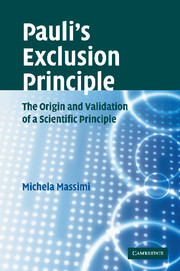Book contents
- Frontmatter
- Contents
- Note on translation
- Preface
- Epigraph
- Introduction
- 1 The exclusion principle: a philosophical overview
- 2 The origins of the exclusion principle: an extremely natural prescriptive rule
- 3 From the old quantum theory to the new quantum theory: reconsidering Kuhn's incommensurability
- 4 How Pauli's rule became the exclusion principle: from Fermi–Dirac statistics to the spin–statistics theorem
- 5 The exclusion principle opens up new avenues: from the eightfold way to quantum chromodynamics
- Conclusion
- References
- Index
4 - How Pauli's rule became the exclusion principle: from Fermi–Dirac statistics to the spin–statistics theorem
Published online by Cambridge University Press: 07 August 2009
- Frontmatter
- Contents
- Note on translation
- Preface
- Epigraph
- Introduction
- 1 The exclusion principle: a philosophical overview
- 2 The origins of the exclusion principle: an extremely natural prescriptive rule
- 3 From the old quantum theory to the new quantum theory: reconsidering Kuhn's incommensurability
- 4 How Pauli's rule became the exclusion principle: from Fermi–Dirac statistics to the spin–statistics theorem
- 5 The exclusion principle opens up new avenues: from the eightfold way to quantum chromodynamics
- Conclusion
- References
- Index
Summary
Shortly after their introduction, the electron's Zweideutigkeit and Pauli's Ausschliessungsregel were embedded into a growing theoretical framework: from Fermi–Dirac statistics in 1926 (Section 4.2), to the non-relativistic quantum mechanics of the magnetic electron with Pauli's spin matrices in 1927 (Section 4.3); from Wigner and von Neumann's group theoretical derivation of the spin matrices in 1927 (Section 4.4), to Jordan's reinterpretation of Pauli's exclusion principle in terms of anticommutation relations for particle creation and annihilation operators in 1928 (Section 4.5), which paved the way for quantum field theory. The most important step in building up this theoretical framework was the transition from non-relativistic to relativistic quantum mechanics, with Dirac's equation for the electron in 1928 (Section 4.6), which finally allowed the derivation of the electron's spin with its anomalous magnetic moment and hence clarified in a conclusive way the origin of spectroscopic anomalies. The negative energy solutions of the Dirac equation, and Dirac's attempt to accommodate them via the hole theory in 1930, anticipated the experimental discovery of the antiparticle of the electron, the positron. Sections 4.7-4.9 reconstruct Pauli's sustained criticism of Dirac's hole theory. The history of this debate is intertwined with Pauli's search for a spin–statistics connection, which finally culminated in the spin–statistics theorem in 1940. With this theorem, the nomological shift from the status of a phenomenological rule to that of a fundamental scientific principle is finally completed.
Introduction
The year 1925 was the annus mirabilis for quantum mechanics.
Information
- Type
- Chapter
- Information
- Pauli's Exclusion PrincipleThe Origin and Validation of a Scientific Principle, pp. 112 - 144Publisher: Cambridge University PressPrint publication year: 2005
